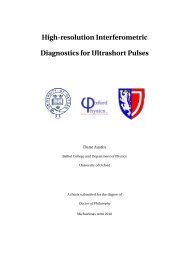B3: V. General Relativity and Cosmology, and VI. Condensed-Matter PhysicsEach section is 1.5 hour in duration and has four questions.Answer two questions in each section <strong>of</strong>fered.V: General relativity and cosmologyNewtonian gravity, examples <strong>of</strong> two body and spherical configurations;Gravitational and inertial mass; the Einstein equivalenceprinciple.Accelerating frames, metrics, covariant derivatives and the geodesicequation; connection between metric and the Newtonianpotential; the Newtonian limit. [Non examinable: GPS.]Gravity and light: gravitational redshift, deflection <strong>of</strong> light, lensing.Curvature <strong>of</strong> spacetime; the curvature tensor; Ricci tensorand scalar.Einstein field equations: the Einstein tensor, symmetries, theenergy-momentum tensor, the conservation <strong>of</strong> energy, relation <strong>of</strong>curvature and energy; Poisson’s equation in the Newtonian limit.Experimental tests <strong>of</strong> General Relativity: planetary probes; Hulse-Taylor pulsar; emission lines from accretion discs.Homogeneous isotropic spacetimes, Friedmann equations, redshift,scale factor, luminosity distance.The expanding universe: its contents and energy-momentum tensor.Closed and open universes. Cosmological distance ladder,Hubble constant and deceleration.Thermal history <strong>of</strong> the universe. Saha’s equation and the CMB;decoupling between photons and baryons; observations; nonequilibriumn/p abundance, freeze out and the formation <strong>of</strong> thelight elements.VI: Condensed-matter physicsFree electron model <strong>of</strong> metals, Fermi energy and Fermi surface.Drude theory, conductivity and Hall effect (one carrier only).Lattice vibrations: law <strong>of</strong> Dulong and Petit; phonons; dispersionrelation with two atomic types: acoustic and optical branches;Einstein and Debye models <strong>of</strong> heat capacity.Structure and types <strong>of</strong> condensed matter. Bonding <strong>of</strong> atoms: ionic,covalent, van der Waals, metallic [Non examinable: hydrogen].Elasticity and thermal expansion.Crystals. Bravais lattices, lattice planes, Miller indices and unitcells (conventional and primitive). Reciprocal lattice: Braggand Laue formulation <strong>of</strong> diffraction; Brillouin zone; neutron andx-ray scattering.Electrons in periodic potentials; tight binding model; band structure;Fermi surface; semiconductors and insulators. Semiconductors:Doping; law <strong>of</strong> mass action; direct and indirect band gap;concepts <strong>of</strong> holes and effective mass; mobility and Hall effect insemiconductor [Non examinable: p-n junction, MOSFET].Magnetism: Para- dia-, ferro-,antiferro-, and ferrimagnetism;application <strong>of</strong> Hund’s rules to determination <strong>of</strong> magnetic groundstates <strong>of</strong> isolated ions; Local Moment vs Itinerant magnetism.Mean field theory. Domains, domain motion, hysteresis.44
Appendix FFOR FIRST, SECOND and THIRD YEAR STUDENTSSyllabuses for Short OptionsShort Options will be examined by a single compendium paper divided into sections - one for each option - each containing 3 questions.Candidates <strong>of</strong>fering one Short Option should attempt two questions from one section in 1½ hours. Candidates <strong>of</strong>fering two Short Optionsshould attempt two questions from each <strong>of</strong> two sections in 3 hours. All questions are worth 25 marks. For restrictions and otheradministrative details, refer to page 28.S01: Functions <strong>of</strong> a complex variableComplex differentiation and definition <strong>of</strong> analytic functions,Cauchy-Riemann equations, orthogonal families <strong>of</strong> curves andcomplex mapping, conformal transformations and applications.Complex integration, Cauchy’s integral theorem and integral formula,Taylor series, isolated singularities and Laurent series, residuetheorem and evaluation <strong>of</strong> real integrals, Jordan’s lemma andother types <strong>of</strong> integral, branch points, branch cuts and Riemannsurfaces, integration with cuts or with removable singularities,other selected applications <strong>of</strong> complex calculus.S02: Astrophysics: from planets to the cosmosThe Solar system and Kepler’s Laws. Extra-solar planets. TheSun and the basics <strong>of</strong> stellar structure. A qualitative view <strong>of</strong> starformation, stellar evolution and the synthesis <strong>of</strong> heavy elements.Non-interacting binary systems and the masses <strong>of</strong> stars. Interactingbinary systems. Black holes. Galaxies. Clusters <strong>of</strong> galaxies.The evidence for dark matter, including gravitational lensing. Theexpansion and origin <strong>of</strong> the Universe.[Note that knowledge <strong>of</strong> the prelims mechanics and special relativitycourses will be assumed.]S03: Quantum IdeasThe success <strong>of</strong> classical physics, measurements in classical physics.The nature <strong>of</strong> light, the ultraviolet catastrophe, the photoelectriceffect and the quantisation <strong>of</strong> radiation. Atomic spectrallines and the discrete energy levels <strong>of</strong> electrons in atoms, theFrank-Hertz experiment and the Bohr model <strong>of</strong> an atom.Magnetic dipoles in homogeneous and inhomogeneous magneticfields and the Stern-Gerlach experiment showing the quantisation<strong>of</strong> the magnetic moment. The Uncertainty principle by consideringa microscope and the momentum <strong>of</strong> photons, zero point energy,stability and size <strong>of</strong> atoms.Measurements in quantum physics, the impossibility <strong>of</strong> measuringtwo orthogonal components <strong>of</strong> magnetic moments. The EPRparadox, entanglement, hidden variables, non-locality and Aspect’sexperiment, quantum cryptography and the BB84 protocol.Schrödinger’s cat and the many-world interpretation <strong>of</strong> quantummechanics. Interferometry with atoms and large molecules. Amplitudes,phases and wavefunctions.Interference <strong>of</strong> atomic beams, discussion <strong>of</strong> two-slit interference,Bragg diffraction <strong>of</strong> atoms, quantum eraser experiments.A glimpse <strong>of</strong> quantum engineering and quantum computing.Schrödinger’s equation and boundary conditions. Solution fora particle in an infinite potential well, to obtain discrete energylevels and wavefunctions.S07: Classical Mechanics*Calculus <strong>of</strong> variations: Euler--Lagrange equation, variation subjectto constraints.Lagrangian mechanics: principle <strong>of</strong> least action; generalized coordinates.Application to motion in strange co-ordinate systems,particle in an electromagnetic field, normal modes, rigid bodies.Noether’s theorem and conservation laws.Hamiltonian mechanics: Legendre transform; Hamilton’s equations;examples; Liouville’s theorem; principle <strong>of</strong> least action(again); Poisson brackets; symmetries and conservation laws;canonical transformations; Hamilton-Jacobi equation.* also for the Physics and Philosophy paper BT:VII. Classical MechanicsS09: Financial PhysicsAn introduction to the physics-based approach to finance theory(so-called ‘Econophysics’). This interdisciplinary field aims toapply ideas and mathematical techniques developed in physics(particularly those related to statistical mechanics) to improve ourunderstanding <strong>of</strong> the empirically observed fluctuations in globalfinancial markets. Emphasis is placed on the extent to which assetprices deviate from random walk behaviour, the development <strong>of</strong>microscopic models which may help to explain these deviations,and the minimization or hedging <strong>of</strong> financial risk.S10: Medical Imaging and Radiation TherapyThe physics that is applied in imaging, diagnostics, therapy andanalysis in medicine: Interaction <strong>of</strong> X-rays with matter (Photoelectric,Compton, Pair Production); X-ray imaging (scintillation anddiode detection) and Computed Tomography; Magnetic resonancefundamentals, basic imaging & slice selection, functional imaging(diffusion-weighted imaging, dynamic contrast-enhanced imaging,spectroscopy); Ultrasound and its application to imaging, includingDoppler imaging; Use <strong>of</strong> radioisotopes: Gamma cameras, SPECT,PET & radionuclide therapy; Radiotherapy: microwave linacs,bremsstrahlung, beam collimation, portal imaging; Introductionto radiotherapy planning: CT simulation, conformal therapy,IMRT, charged particle therapy; Radiation Dosimetry (ionisationchambers, film, diodes, TLDs); Safety considerations;Comparisons between imaging methods.45









![Extended Notes 8 [pdf]](https://img.yumpu.com/50123548/1/190x245/extended-notes-8-pdf.jpg?quality=85)




![Handout 3 [pdf] - University of Oxford Department of Physics](https://img.yumpu.com/46475432/1/190x245/handout-3-pdf-university-of-oxford-department-of-physics.jpg?quality=85)